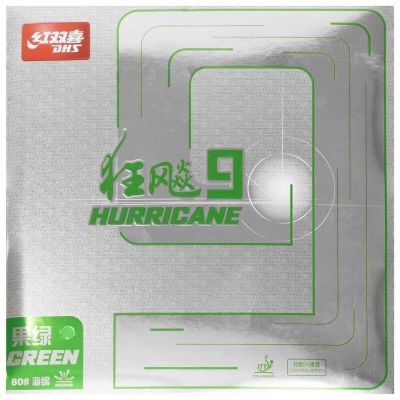Review date: 17 January 2024
DHS has four different rubbers in the Hurricane 9 series – blue, pink, violet and green. All four rubbers have different playing characteristics, but are all a little easier to play with than some of the very hard Chinese rubbers. They are a bit softer and have bouncier sponge. I tried out the green version for a few hours of play.
The green rubber is supposed to have good control, so I was quite interested to see if it would suit my game. In the review I go into more detail about what I liked and didn’t like. I tested the rubber using the TIBHAR Felix Lebrun Allround Blade.
Tom’s rubber ratings Speed = 6 Spin = 7 Control = 9 Hardness = Medium Throw angle = Medium Where to buy Bribar Table Tennis (UK and worldwide) |
Spin generation
Out of the box, the rubber is very tacky, but the tackiness didn’t last very long and it didn’t feel like other very tacky rubbers I have used. It was quite easy to play with straight away. I didn’t have to make too many adjustments to my drives and topspins. It had more of a feel of a European style rubber, rather than a very hard Chinese rubber.
The spin generation is OK. I wouldn’t say it was brilliant. When playing topspin shots, the ball arcs over the net quite nice, but there just doesn’t seem to be that much rotation. Maybe this is a reflection of my technique, but to really generate some good spin, I feel you would need to have a more dynamic stroke with lots of acceleration.
Counter attack
The best thing about this rubber is counter-attacking. As it is a little tacky and not too fast, it is very easy to counter-hit or counter-topspin your opponent’s topspin attacks. I had great confidence that my counter-attack was going to land on the table and not fly off the end, which can often happen with faster rubbers. In fact you can counter attack quite hard and it still feels as though the ball is going to land on the table.
Speed
It’s not a particularly fast rubber. This has pros and cons. On the con side, I did find that if I was too passive against a medium paced ball, I could easily put the ball into the net. So I had to make sure I was playing an active shot every time. On the pro side, the lack of speed means you can swing quite hard at the ball and still have confidence it is going to land on the table. If you’re the sort of player who has bigger swings and you’ve got quite strong attacks, this rubber might work for you. The ball dips down nicely and with the lack of speed, you can swing as hard as you like!
Touch play
Another positive about this rubber is you can keep your touch shots and pushes low over the net and tight to the table. When pushing I did have to make a slight change to my bat angle to make sure the ball went over the net. But I’d rather this be the case, than finding my pushes popped up too high. Once I got the angle right, I found it easy to push with good quality.
Serving
It’s a good rubber to do short backspin serves. The ball stays low off the rubber and it seems to skid off the table and stay very low, which is ideal for a backspin serve. One player commented that my backhand serve had really improved. I’ve not been working on the technique recently, so it must have been the rubber giving him more problems!
But I did struggle to get real quality on my long, fast, spinny serves. With the lack of speed, I struggled to get the depth. And with the average spin generation, I just couldn’t seem to get the same zip that I am used to. To get really good spinny servers from this, you really have to whip the ball a lot.
Looping vs backspin
Perhaps the hardest thing I found with this rubber was looping against backspin. With my technique – which isn’t the greatest – I wasn’t get much effect on the ball. My loops lacked depth, speed and spin and weren’t that threatening. I suspect my technique doesn’t match up that well with this rubber. If you’ve got a more dynamic looping action, using a straighter arm and more horizontal swing, with lots of acceleration, you may well achieve some decent speed and spin.
Who should use this rubber?
I feel that this rubber is most suited to a couple of styles of play. It could work for players who have an all-round style of play – mixing pushes, blocks and strong attacks. It could also work for very aggressive attackers who have big swings and need a rubber which allows them to hit hard but still keep the ball on the table.
Here’s a video review, where you can see footage of me using the rubber with my PowerPong Omega robot …
Where to buy

